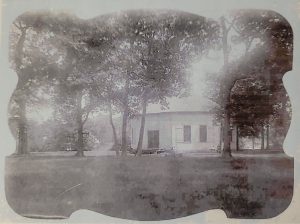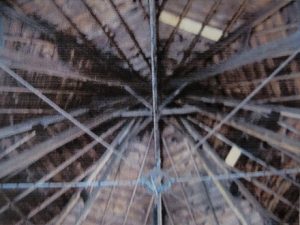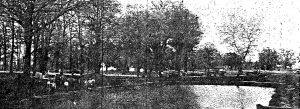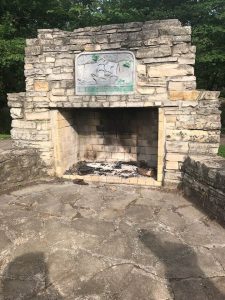The Pavilion

In 1891, John C. Nye had plans for a park that would attract large crowds of people willing to pay admission to attractions that would be scheduled. With this in mind, he commissioned his father, Cyrus Nye, to build a pavilion for public use. It was intended to seat more than Vurpillat’s meeting place.
J.C. Nye has received plans and specifications for his new park building on the peninsula, and as soon as the weather permits work on it will begin. It will be octagonal in shape, forty-five feet in diameter, with a large stage at one side in addition. It will be sixteen feet high to the square, with an arched ceiling. It will have a self-supporting roof, without any posts except in the side walls, and exclusive of the stage will seat 1,012 persons. Oh, it’s a hummer. Pulaski County Democrat June 3 1892
The Pulaski County Teacher’s Institute was the first to meet there, and after them came band concerts, dances, Sunday schools and political conventions.
During the summer months it was the coolest place in town and in great demand.

When John Nye sold the park in 1908, the new owner intended to move the pavilion to his farm, but this disaster was averted by the Winamac Park Association, a group quickly formed to rescue the peninsula and all its attractions from destruction.
The pavilion continued to be a popular place and was in constant use for decades. Time and the river began to take its toll and in 1990, the nearly one hundred-year-old building was condemned and was to be torn down.
The M.E. Church has secured the use of the pavilion in Nye’s park during the heated term, and they will hold Sunday services there until further notice. Services are announced for the same hours as when they were held at the church. The object of the change is to find a cool place in which to conduct meetings, Sunday school and preaching. Pulaski County Democrat July 28 1893
Enough people remembered its glory days to want to save it. Nearly a foot of insect-infested and rotted wood was cut off the bottom and it was moved to the other side of the park. It has been listed as Pulaski County’s only round barn, even though it is not exactly round and was never used as a barn. It did, however, come very close to being a granary.
Winamac Conservation Club

The Winamac Conservation Club was created in 1933. In 1940, the club financed a fish hatchery pond in the town-owned park. The pond was approximately 90 feet by 200 feet; a minimum of eighteen inches of water were to be maintained at all times.
By early December, 8,050 little rock bass had been hatched and released into the river. With winter approaching, it was decided to turn the pond into an ice skating rink. The fire department pumped the pond full of water and waited for freezing weather. They needed to keep the skaters warm, so it was decided to build an added convenience for public enjoyment.

A large open fireplace, located between the pond and the river’s edge, was completed during the first week of December 1940. Twelve tons of limestone were used in the building of the fireplace. Embodied in the mantle is a 600-pound granite plaque, a gift of J. Lon McKinley.
The Club built a bird sanctuary and observation hut in 1941. Located north of the 4-H barns, it provided a natural habitat for the study of bird life. The sanctuary included a 45’ x 90’ feeding area surrounded by a wire fence with a bench and feeders placed along the ground to attract wild birds.
In 2018, after 85 years, the club closed and established the Winamac Conservation Club Scholarship with the Community Foundation of Pulaski County. The fish pond / skating rink was never successful and is now buried under a ball diamond. The bird sanctuary is no longer standing. The fireplace is still in use, only now it is roasting hotdogs in the summer and not toasting ice skaters in the winter.
Park Debt Retired By Rogers
In 1931, Richard S. Rogers, living in Alhambra, California, began to announce gifts to be left in trust upon his death. Totaling $12,000, the fund was divided among the Winamac Town Park ($5,000), Winamac Cemetery ($3,000), Winamac Christian Church ($2,000), the Indiana Masonic Home ($1,000), the Winamac Public Library ($500), and the Indiana School for the Blind ($500).
Born in Logansport on October 15, 1853, he came early to Winamac. When quite young, he worked for the Democrat Journal. Later, he worked on the railroad in Illinois, where he contracted smallpox. He carried the scars for the rest of his life.
In the late 1870s, he worked with his stepfather, James R. Dukes, in a general store known as Phillips Store, selling dry goods and shoes. The store was on Pearl Street, near a store owned by J.D. Vurpillat. When the brick block was built by Vurpillat, known to many as Vurpillat’s Hall or Vurpillat’s Opera House, Mr. Dukes and Mr. Rogers organized Citizens Bank. It was located on the premier corner storefront, facing both west and south.
The bank weathered the panic of 1893, but in 1886 or 1887, the bank was liquidated after paying all debts. Mr. Rogers then started a private loan agency.
Mr. Rogers and his wife moved to California in 1918. Mrs. Rogers died in 1931, perhaps prompting his interest in leaving funds in trust to their hometown. They left no surviving relatives. The funds were dispersed upon his death on July 5, 1945.
The Old Man at the Desk has a colorful story of Mr. Rogers and his further contribution to the park. (This column was copied and in a file at the Library but was not dated.)
Directors of this organization, known as the Winamac Park association, operated the park for several years. Various prominent citizens gave of their time and efforts as such officials. During boom times that followed the first World War, more stock in the association was sold to raise funds for construction of the permanent suspension foot bridge. Quite a number of the stock purchasers felt that the money would earn them some dividends.
But it didn’t work out that way. Some years, rentals and concessions enabled the board to break even or a little better. Other years the books showed red. Still more red ink was needed when the depression hit in the early 1930s. The banks held notes to the amount of $1,135.
Now let’s go back into the early 1880s, when Richard S. Rogers left his job on the railway and came to Winamac to make his home. Naturally of a cordial nature, “Dick” soon became a respected and successful resident of the community. After engaging in the mercantile business for a time, he became cashier of the old Citizens Bank. Later he carried on a money lending business. [Editor’s note: Apparently the Old Man at the Desk did not know that Mr. Rogers lived here as a child.]
In 1918 he sold his interests here … including his red Maxwell runabout … and he and Mrs. Rogers moved to Southern California. They had no children, and no other relatives except a few on Mrs. Rogers’ side. She died in 1931. Dick survived her by fourteen years.
Left alone in the far west, his thoughts must have turned often to the scenes of his young manhood. He bought an electric organ for the Christian church in Winamac, of which he and Mrs. Rogers had long been active members. He recalled also, no doubt, the hours he had spent on the “Barnett peninsula.”
Informed of the predicament in which the then-owners of the park had found themselves … the eighty-five persons who held stock in the association … he proposed that he would pay off the $1,135 debt if the stockholders would deed the property to the Town of Winamac, the town to levy a small tax for maintenance of the park thereafter.
Stockholders were interviewed by park directors, some in person and some by mail. Several had died and left heirs. In due time a majority of the owners agreed to the Rogers proposition, empowering the directors to proceed with the transfer.
Thus eighty-five citizens of Winamac (including some who had moved away) presented to the Town their 285 shares of stock. At $25 a share, this amounted to $7,125, or a little more than six times the sum which Mr. Rogers was contributing. The Town accepted the property, levied the tax and assumed management.
An additional feature of the Rogers proposition was that he would set up a trust fund of $5,000 to be paid to the park upon his death. He drew interest on the money during the remaining eleven years of his life, and left no direct heirs who would have been entitled to the money if he had not left it to the town. In other words, his gift during his lifetime amounted to the $1,135, and no more.
Mr. Rogers placed two other minor items in his gift specifications, to the effect that no intoxicating liquor shall ever be sold or given away in the park, and that no persons shall ever be refused admission because of their nationality, politics, color or religion. Contrary to statements that have sometimes been made, there was never any stipulation against charging admission to the park or any part thereof.
Looking Ahead
May: Part 4: Park Entryway
Previously
March: Part 2: Artesian Well / West Side
